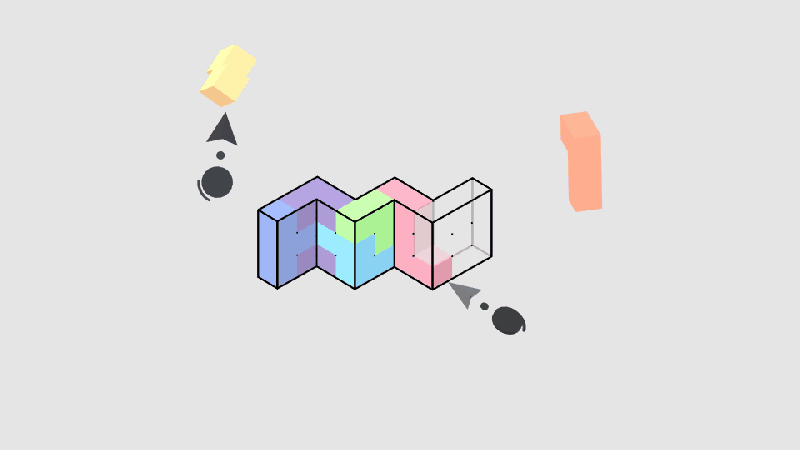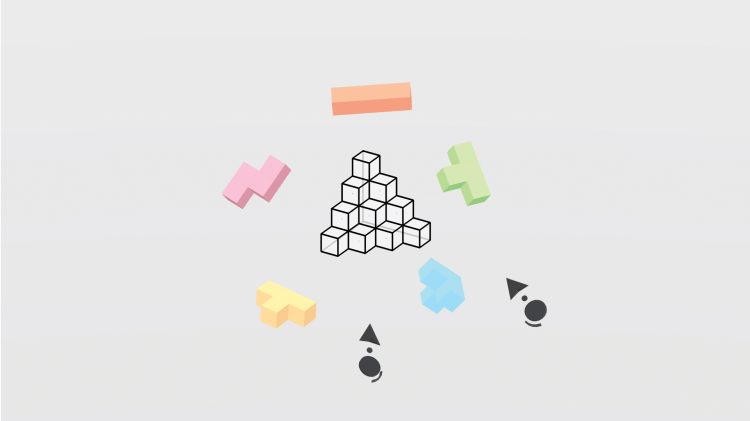Cubism is an elegant puzzler about building 3D shapes in virtual reality. It’s the latest game from indie developer Thomas Van Bouwel, who previously worked on the VR game Panoptic, and it will launch later this year for the Oculus Rift, HTC Vive, and Windows Mixed Reality headsets. A free demo is on Steam and Itch.io.
I tried it at the VRLA event earlier this month, and it was a peaceful experience away from the chatter of the rest of the showfloor. You sit in a vast white empty space with the outline of a shape before you. Scattered about are puzzle pieces, all rendered in soft colors that remind me of sidewalk chalk, and you figure out how to fit these into the shape.

Above: Cubism is Thomas Van Bouwel’s minimalist VR puzzler.
“A big inspiration to start making the game was that I’m a big fan of where mobile games are these days,” said Van Bouwel in an interview with GamesBeat. “There’s a lot of cool abstract mobile games, like Mini Metro. It’s so simple in terms of its aesthetics. It only has what it needs to convey the gameplay. I also wanted to make something that tears away all the fat from the design and focuses down on gameplay.”
Cubism features wonderfully VR-native mechanics. It’s all about the tactile experience of fitting its puzzles together and rotating the shapes as you figure out your next move. Of the 12 levels in the demo, I only struggled with the last one. The rest were pleasant brainteasers that challenge you to think spatially, turning the jigsaw pieces in your hands and rotating the grid as you try to imagine how to make the two fit together.
Van Bouwel says that he’s tried to design the puzzles so that they’re not “frustratingly difficult.” Normally, they each have a “constraining piece” — a weird component that forces you to work around its awkward angles or a grid that makes it so that each shape has to pass through its center at least once.
“Usually I try to find an interesting shape for the grid, or an interesting geometric system,” said Van Bouwel. “As I draw the pieces for the grid, I try to solve it and make sure the pieces look interesting. Then, when I’m done, I try to solve it again. I’ve had instances where I design a puzzle, and when I try to solve it afterward I’m unable to do it, because it’s just too hard, or the pieces are too small. There’s no good sequence of solving it. The best puzzles, there’s a constraining piece. You have an obvious first step, and from that first step there’s an obvious second step, and through a bit of iteration you can find a solution.”
Van Bouwel has a background in architecture, and by day, he designs VR software for architects at the Brooklyn-based startup InsiteVR. He’s been working on Cubism as a solo project since last June, and he says it’s gratifying to be able to quickly show people what he’s working on instead of the drawn-out creative process involved with architecture.
“The architectural design process can be very long and frustrating,” said Van Bouwel. “You can work on a project for years and it’ll still fall through because there’s no funding, or if you’re doing a public project there’s another election and the project gets scrapped. There can be a long process before you see people using your designs, see it coming to fruition. The nice thing about software is it’s so direct. I can build a prototype in a weekend, which is what I did for [VRLA]. I spent two days hacking something together and I just showed it to people and got feedback.”
The full version of Cubism will have more than 50 levels, and Van Bouwel is working on adding some other features and polish as well, like music and sound effects. He’s toying with adding a “dark mode” that converts everything to black and white for folks who don’t care for its colorful sherbet look.
Though many of the VR demos I’ve tried lately have been riding the adrenaline rush — like Stuido Studios’ rambunctious party game The Take or Twisted Pixel’s explosive ’90s espionage shooter Defector, it’s nice to see a game that beseeches you to slow down and have a Zen experience at your own pace.

